#mabel ridgeway
Explore tagged Tumblr posts
Text
The Road to Freedom- Colon Whitehead's The Underground Railroad.
TW: possible mention of slavery and racism
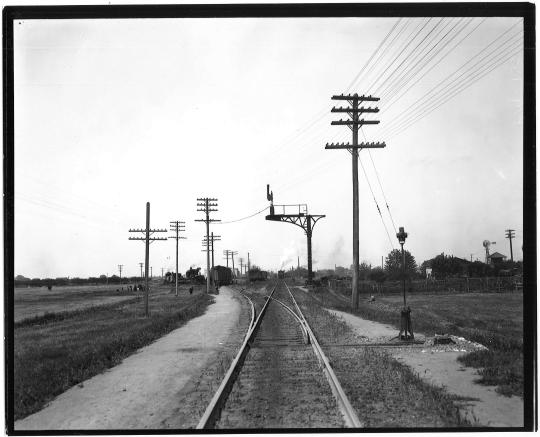
Martin, Van Covert. 2019. ‘Railroads-Stockton: Assorted Photos of Railroad Track, Freight Cars and Locomotives’, JSTOR < https://www.jstor.org/stable/community.28398618 > [accessed 4 May 2023]
TW: possible mention of slavery and racism
The main character Cora goes through some serious and important character development, regardless of whether you watch it on your TV or read the novel. The way she thought, and acted at the beginning of the storyline compared to the end differs, through other people’s stories and her own as well. Another bonus would be the fact that majority of the novel is told in her point of view. (Let us ignore the concept of the unreliable narrator and go with what Cora tells us.) This is also influenced by the struggles and tribulations she faced while being on Ridgeway’s plantation field as a slave. In addition, the way she felt towards her mother at the beginning on the novel was full of hatred and a sense of abandonment as well, under the interpretation that her mother had left the field she “thought of her as little as possible […] she had banished her mother not from sadness, but from rage. She hated her.” (Page 74) But by learning the truth about her mother (the fact that her mother tried to escape and failed) she uses as a form of inspiration to escape, in which she successfully does.
Although I chose the motif of the railroad, it is not in a straight line. Whitehead throws everyone off by showing a resistance to chronological order, a reflection of the resistance to racism and abuse suffered by the black community, which follows to this day, that although we are free, there is still that feeling of being trapped and caged, and not being able to see a straight route to escape to genuine freedom.
We do not find out about Mabel’s escape until over 300 pages into the novel, in the eleventh chapter, where we find out the truth behind Cora’s mother’s disappearance. She was killed after being bitten by a snake in a swamp and “Cora is a reminder of his (Ridgeway’s) past failure to catch Mabel.” (Phil Owen, The Wrap) In the movie series, ‘The Underground Railroad’ the mother of Cora is a very sweet person, labelled “a hugely compassionate person” (The Wrap) but that contrasts with leaving her daughter.
The railroad that Whitehead leads us on is full of steps forward and back, and should not be considered something sentimental, as “Whitehead’s novel uses speculative literary strategies in order to enact political satire if real histories, that, of course, stretch to the present.” (States of Possibility in Colson Whitehead’s The Underground Railroad) This novel shows just an insight as to the history for people of colour, and Whitehead uses that historical railroad as a hope for a way out for those in the black community.
As we walk along this railroad, another sharp turn would be the historical accuracy according to the novel. When Whitehead was writing this story, the railroads were not even invented yet, and “Whitehead’s vision presents utopia as a condition of necessary and perpetual movement that inspires structural revolution and change.” (Farooq- ‘A Useful Delusion: Valentine Farm and the Flight for Freedom, pg. 87) It comes across as a dream, an ambition for emancipation, but even in the present day so many years later, there isn’t a railroad to freedom and the possibility of “reparative justice” (Page 82, Matthew Dischinger, 'The Global South ' 'States of Possibility in Colson Whitehead's The Underground Railroad').
But there is hope. Cora does escape and “put miles behind her,” (page 216) and there is the possibility that black people can do the same, and move forward into a brighter future, along a railroad that leads to greatness, not one of despair, confusion, and the past. 606 words
0 notes
Photo




It was the annual Big Summer Blowout in Henford! The marketplace and businesses shut down for the day so sims could have some fun in the sun with those they cared about the most. For Mabel, that meant a BBQ in the park with Michael, Sara and Simon, and Honey too! . Baby Cole was at home with a sitter because the sun was too dangerous to be out in all day for such a little sim.
Michael was on grilling duty. which made a change as normally Mabel did all the meal prep on big occasions. She wasn’t going to complain about the day off though. In reality, Michael didn’t volunteer to grill purely to let Mabel enjoy the day, it was also to keep his mind busy and out of conversations. Although he was a loner and often pretty quiet, he was even more on edge in social situations than before. What if someone knew? Kim was quite often in the Gnome’s Arms, so maybe she said something? He didn’t expect them to say anything today, but the thought of it still had him a little on edge.
#the sims#the sims 4#sims#sims 4#ts4#simblr#ridgeway#ridgeway gen 1#ridgeway legacy#ridgeway family#mabel ridgeway
26 notes
·
View notes
Text
Palisman for Plaismanless Adult Witches
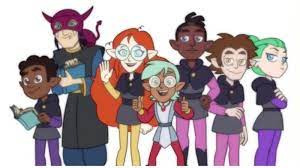
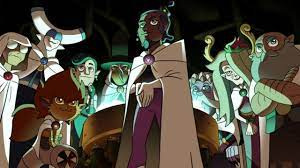
Yeah I wanted to do more witch and Palisman pairings, they are one of my favorite parts of the owl house. Well I noticed that most of my idea’s and pairings are for children, but since the previous generation where born and raised under Belos’s control, many of them do not have Palisman either, so why not fix that? Here are picks for the coven heads, the parents, and other adults we frequently see. Note I am giving some of the villain/bad adults palisman as well, it was kinda fun thinking up what they would get. Boshca, Gavin, Hermunclus, and the Glandis principal all have Palisman even though they are antagonists (Well the Glandis principal probably is based on how he runs his school). So I figure each character has some kinda drive that the palisman link to (Boshca and Maya) or some palisman are made with harsher desires than others.
Darius Deamonne: One of the easier ones because his voice actor already told fans that if Darius had a palisman it would be a hawk. The only question left is what breed of hawk? I looked at several breeds (Extra note here I am now pretty sure that Gwendolyn Clawthorne’s palisman, Hawk-sly, is a Ridgeway Hawk. The picture I saw of one showed a hawk with a white head, like a bald eagle). For Darius I would say the classic red-tailed hawk would be best. It is strong, sharp eyed, lightweight, master of the sky, and has some of the most elagent and individualized plumage of any Hawk. Red-tailed hawk for Darius.
Raine Whispers: I saw a post that said Raine’s voice actor was asked the same question as Darius, and they answered that Raine would have a Penguin, they also said that Raine’s penguin would either be named Gatsby or Waddles ( Raine Whispers and Mabel Pines meeting, and introducing their same-named-animals to each other, then talking about bard hobbies they do with them). Once again we just need to choose a breed. Now the classic penguin model is an emperor penguin, but for obvious reasons that will not work for traitor to the throne, rebel leader, Raine Whispers. neither would a king penguin or a crown penguin. I would say the best type of penguin for Raine would be the african penguin. It is slim, has an adorable and still fairly well known black and white stripey design. Is both strong and fast, mates for life, and has no affiliation to outdated system’s of monarchs.
Eberwolf The Huntsman: I looked and looked to see if any one had asked Eber’s voice actor about palisman but found nothing (Why ask the other two but not Eber’s?), so It looks like I will have to pick based on what I know about Eberwolf... I pick a tarantula/giant spider. Sipders are small, fierce, master hunters, like Eberwolf. Spiritually they represent connections and interwoven webs between others. Eberwolf is deeply contected to the beasts on the isles through beast keeping, and the CATT”s since as people have pointed out he is the one who keeps Darius and Raine focused, and is generally the first to move. Also you know how Principal Bump has a staff for Frewin, but normally carries him around on his head? I cannot see Eberwolf carrying a staff around. He runs everywhere, and when he is not running he rides on giant worms (or on Big Bro Darius’s shoulders). So I am imagining that Eber would have a staff just for flying to places when needed, but for ground work the spider would climb on to his back and its legs would turn into backpack straps, so that he could carry them hands free.
Terra Snapdragon: Now we are getting into the “what type of palisman would the baddies bond with”. Terra was surprisingly easy. A poison dart frog. This is a very colorful tropical frog. It’s also very tiny, only about the size of a thumb nail. Terra would not need a staff either, she could probably wear it like a jewel. This frog size makes it look harmless, and again it has really nice, bright, vibrant colors,.. those are a warning, because it’s small fragile looking body is loaded with toxins, and prolonged exposure is hazardous to your health. Just like Terra.
Adrian Graye Venworth: A mouse. We all know who, or should I say what Adrian is based off of; and we all know who, or should I say what its mascot is. No need to make this one harder than it has to be.
Hettie Cutburn: She was a bit harder than Terra. I kept going through witch doctor animals, and really dangerous animals that could hurt you. I finally settled on an electric eal. Just because a patient does not need electroshock therapy, just because it offers no benefit to said patient, is not any reason for Hettie to not suggest shock therapy.
Mason: A beaver It’s brown, burly, good at construction, and I do not think they are all that chatty. With what little we got to see of Mason, him and beaver’s share these traits
Vitimir: A Skunk. Okay I do not think Vitimir is evil. Firstly until I know more about him, Osran, and Mason I am labeling them all as "dumb pawns who could not see that they were being tricked". Secondly the fact that he wears a mask around people unless they start a fight, and only then does he blow acid/poison clouds at them, kinda makes him seem more defensive than out right malice. Like he does not initially want to hurt anyone, but is gonna protect himself in a fight.. But with his “special ability” and the resting anger written clear on his face, I cannot deny that he would be a very unpleasant person to not be on the right side of. A skunk is another animal with a fume related “special ability”, that if encountered you do not want to be on the wrong side of.
Osran: I know nothing about Osran and have some questions as to how Belos managed to trick an elderly Oracle so easily?... Well intelligence isn’t a requirement for being a witch (in this universe), neither is it one for having a palisman. Since Oracle track members fight with ghosts, I will give Osran a little Casper looking ghost palisman. Casper was kinda short-sided too if my memory stands.
Alador Blight: Another pretty easy one as well (this is assuming that the little rat from CATH was not a palisman, but a regular pet). Alador loves butterfly’s and moths. I picked a moth because they are sorta more interesting in meaning. Spiritually a moth means great change is around the corner. In some cultures they are seen as messengers of tragedy,because they are creatures of the dark. (Alador made the abomitron’s that gave the emporer more power, and when he agreed to an increased work week he left his kids more vulnerable to his wife’s abuse). But some cultures also think that moths can mean good changes because they fly towards the light (Alador also said he makes security systems for protecting peoples homes. When he found out just how far down his wife had sunk he destroyed the factory, took the kids, and left). Now moths have as many different breeds as birds. I am going to go with a lunar moth for Alador. They're large, have uniquilly shaped, very aerodynamic wings, and are a beautiful iridescent green with black circles. Very nice to watch, and who knows what inspiration he could gleam from it.
Odalia Blight. A cotton mouthed snake. Okay this women is a snake in the grass, she is tricky, and she is toxic. But she is not a rattle snake or a cobra. Those you know right away are bad news and you should avoid at all costs. From a distance Odalia seems like a sweet middle-aged women, who is trying to balance work, and family, while making it fun for herself. So I am picking a cotton mouthed for her. From a distance they look a bit like a common, harmless, grass/rat snake. It's only when you get closer and see the flattened head that you know they are poisonous. Its only when you get close to Odalia that you notice just how sinister her eyes and smile are.
Harvey Park: Gilbert cannonly has a pig, so I only need to pick for Harvey. I know little about Harvey. In EE when we meet him and Gilbert, Harvey seems the more stern. Well after TTBK a really brilliant fan (not me) wrote a great analysis on Harvey and Gilbert, and the way they seem to handle both magic back then, and parenting now. They said Gilbert was/is more laid-back and optimistic, while Harvey, more than just being stern, is very direct and take charge. If Harvey see’s something that needs to be done, he is not going to wait around or call someone to do it (That will probably be Gilbert if Harvey’s attempt makes it worse) He will role up his sleeves, grab some tools, and try to do it himself. So I will give him a gopher. Because Gopher’s are hard working, independent rodents, who like it best when the are up to their necks in mud and dirt.
Perry Porter. Perry is a former Oracle track witch who is actually a nice guy. He is a news reporter, a single father, brings his son on T.V. with him sometimes, and once let Willow have his mic during a live petrafication event because she had something to say about it. I would say he seems to have similar views as Bump's as far as loyalty to the system. He does his job, but also encourages safe exploration for kids. If the show were longer I might have shipped him with Camila (Eda is with Raine, these two are both single, their kids get along, and he looks kinda similar to her first husband so she would probably find him handsome). I am going to give him a dog, more specifically a Husky. Smart, kind, historically were used to carry mail before air mail became possible
Camila Noceda: I know she is not a witch, but I am choosing to use her. A bangle tiger. She is a tiger mom.
Morton: Everybody remember the kitty palisman that looked like Mew? I want to give Morton one that looks like Gloom or Vileplume. Those are pokemon perfume and potion makers frequently had.
Steve: In my previous post I said he should adopt the purple thing of indeterminable species from Hunting Palismans (I kinda wondered if maybe it was supossed to be a horseshoe crab, one comment I got suggested sting ray). If he cannot adopt them, then maybe a scorpion palisman. Hear me out. We see during his road trip with King, that Steve likes bugs. Steve is not a poisonous guy, he might be the sweetest guy in the Boiling Isles. But he says he was not always like this when he was younger. Scorpions are their most poisonous when they are young, and it lessons with age. 5Steve has gotten better as he grew up and went through life. Also I looked up there meanings and while some of them are not good, scorpions can symbolize light &dark, as well as endings and beganings, more specifically rhe idea that an ending is not really the end. This can reflect how Steve grows to feel about the Emperor’s Coven and his decision to quit.
The Hexside Illusion Teacher: Okay we will discuss her palisman in just a second. Can we discuss her lack of a name first? This is like the best teacher at Hexside (Bump is the best adult, but he is the principal, not a teacher). She deserves a name. I am headcanoning that her name is Mrs.Henrietta Heyfear. Then I am giving her a unicorn palisman. They are large, caring, and powerful, just like her.
Kikimora: (this is after the Emperor is dead, and she cannot just hand one over to him to be eaten) Kikimora always saw herself as this great, and powerful, highly skilled member of The Emperor’s Coven. At the end of it all she was never more than an annoying, yapping, lapdog. Give her chihuahua or Yorkie to match.
Severine: The bipedal deamon who quit the Emperor’s Coven to go back to the Tiny Cat Coven. A kittycorn.
#the owl house#the coven heads#Darius Deamonne#Raine whispers#Eberwolf the Huntsman#Terra Snapdragon#Adrian Graye Venworth#Hettie cutburn#TOH Mason#TOh Vitimir#TOH Osran#odalia blight#alador blight#Harvey Park#Perry Porter#camila noceda#TOH Morton#TOh Steve#kikimora#Severine#The hexside illusion teacher#give her a name#Palisman#Palisman matches#TOH#danna terace
52 notes
·
View notes
Text
ELLIS IN FREEDOMLAND
Spring 1952

Directed by Abby Berlin Produced by Roland D. Reed Written by Arthur Hoerl Music by Albert Colombo Choreography by Alex Romero
Synopsis ~ A 82 minute, technicolor promotional film for salesmen of Westinghouse appliances, featuring the voices of major Hollywood celebrities. Westinghouse claims its electric appliances "freed women from the drudgery of housework." The first half involves dream salesman Ellis at work; the second focuses on the "Spring Sales Event," called "Freedomland."
Westinghouse Electric Corporation was founded on January 8, 1886 by George Westinghouse (1846–1914). The corporation purchased CBS in 1995.
Live Cast
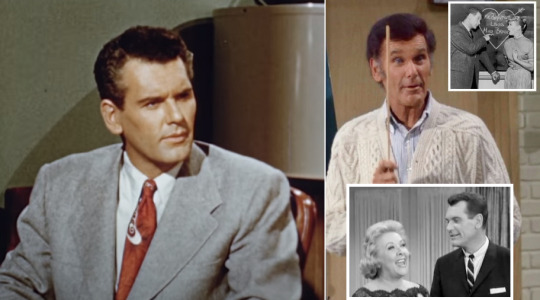
Robert Rockwell (Ellis Homan) is probably best remembered as biology teacher Mr. Boynton on the Desilu series “Our Miss Brooks” (1952-56). Although not the first to play Mr. Boynton, he assumed the role on radio and made the transition with the show to television. He played Viv’s handsome match in “Lucy Digs Up a Date” (TLS S1;E2) the second installment of “The Lucy Show” in 1962. He then played night school teacher Jack Scott in “The Not-So-Popular Mechanics” (HL S5;E23). He continued working until 1995 and died in 2003 at age 82.
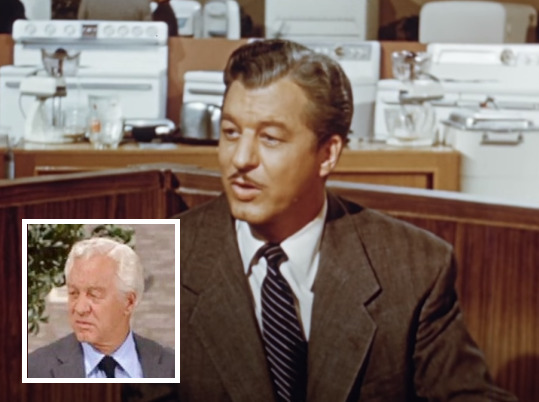
Robert Carson (Phil Pryor, Westinghouse Representative) was a busy Canadian-born character actor who appeared on six episodes of “The Lucy Show” and made five appearance on “Here’s Lucy.”

Byron Foulger (Andy, Night Watchman) played the leader of the Friends of the Friendless in “Lucy’s Last Birthday” (ILL S2;E25). He appeared on “The Lucy Show” in “My Fair Lucy” (TLS S3;E20) and “Lucy Meets the Law” (TLS S5;E19).
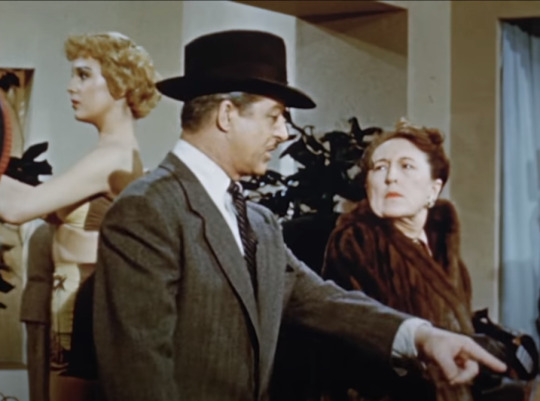
Ann O'Neal (Customer in Mink) appeared in more than 100 films in the 1940s including the Lucille Ball film Lover Come Back (1946).
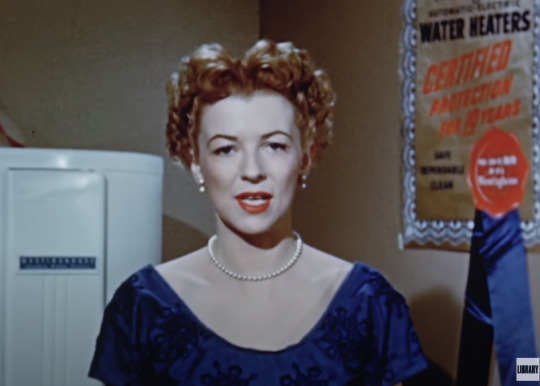
Betty Furness (Herself, Spokeswoman for Westinghouse) was an actress and model who became the face and voice of Westinghouse in many television commercials. When “The Lucy-Desi Comedy Hour” was sponsored by Westinghouse, Furness appeared with Lucille Ball and Desi Arnaz in commercials for their products.
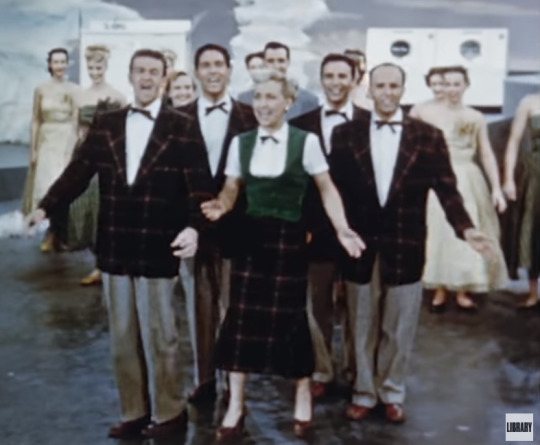
The Starlighters (Vocals) was a singing group that performed mainly as backing vocalists, frequently backing Jo Stafford as well as many other artists on a number of singles. They also performed songs in cartoon and live short films and the feature films Song of Idaho (1948) and With a Song in My Heart (1952).
Voice Cast

Lucille Ball (Lina the Laundromat) was then filming the second half of her first season of “I Love Lucy” playing Lucy Ricardo, although her voice alone was familiar to radio audiences as Liz Cooper in “My Favorite Husband.”
Edward Arnold (Speedy the Range) lends his deep baritone voice to the role. He appeared with Lucille Ball in Roman Scandals (1933) and Ziegfeld Follies (1945). He died in 1956.
James Mason (Frosty the Refrigerator) was a three time Oscar-nominee who appeared as Lucille Ball’s Angel in Forever Darling (1956).
Percy Kilbride (Drip the Dehumidifier) was best remembered as Pa Kettle in a series of films from 1947 to 1954.
Jerry Colonna (Chop-Along Waste-Away the Garbage Disposal) was a comic sidekick of Bob Hope on radio and television. In 1966 he played Smithers, Lucille Ball’s chauffeur on “Bob Hope’s Leading Ladies”.
Andy Devine (Lanky the Water Heater) brought his high-pitched raspy voice to the film. He was known for his many appearances in westerns on both the small and big screen.
Marie Wilson (Dinah the Dryer) is best known for playing the title role in the film and television series “My Friend Irma”. Later in 1952, Wilson and Lucille Ball were both part of “Stars in the Eye” celebrating the opening of CBS Television Center. Coincidentally, Gale Gordon’s mother Gloria was also in “My Friend Irma” and on “The Lucy Show” Mr. Mooney’s off-screen wife was named Irma in her honor.
Maureen O'Sullivan (Pearly the Dishwasher) played Jane in the early Tarzan films. Her career lasted from 1930 to 1994. In 1987, Lucille Ball and O’Sullivan were two of the many stars in “Happy 100th Birthday, Hollywood”.
Mannequins
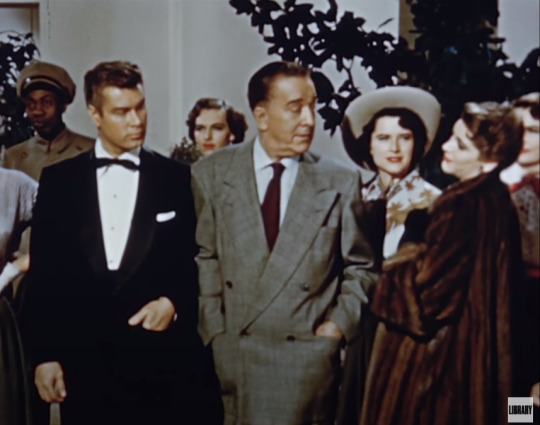
Jack Mulhall appeared with Lucille Ball in Broadway Bill (1934).
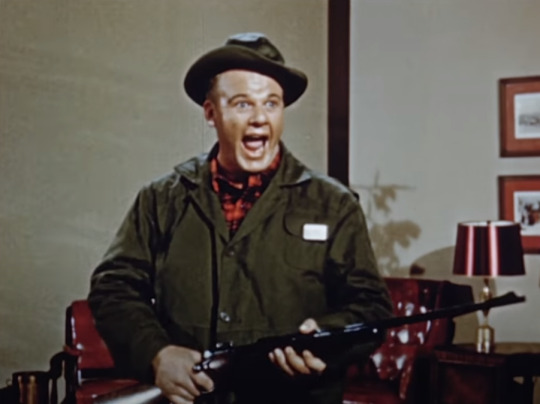
Alan Hale Jr. (Hunter) will forever be remembered as the Skipper on “Gilligan’s Island” but also appeared with Lucille Ball on “The Lucy Show” and “Here’s Lucy”.
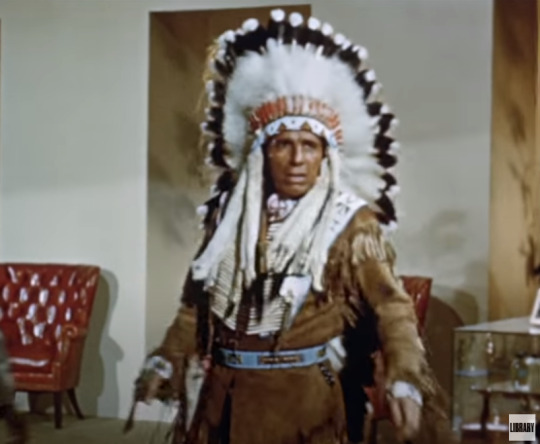
Iron Eyes Cody (Chief Running Water) made a career of playing Native American characters despite the fact that he was of Italian ancestry. He first worked with Lucy and Desi in 1940’s Too Many Girls and 1942’s Valley of the Sun both as an Indian character. He played an Eskimo in a 1959 episode of “The Lucy-Desi Comedy Hour,” but is probably best remembered as the Indian that sheds a single tear in the ��Keep America Beautiful’ ads that ran from 1971 to the 1980s. He played a Navajo Medicine Man in “Lucy and the Indian Chief” (HL S2;E3).
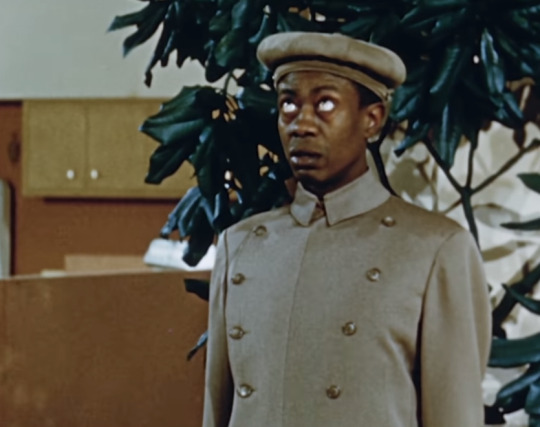
Willie Best (Chauffeur) was one of the most popular African-American actors of Hollywood's Golden Era. He starred alongside some of film's great comedians including the Marx Brothers, Bob Hope, Laurel and Hardy, and three films with Shirley Temple. He did one film with Lucille Ball: Muss ‘em Up (1936).
Karen Sharpe appeared on the “Westinghouse Desilu Playhouse” in 1959.
Mickey Simpson appeared with Lucille Ball in the 1939 film Panama Lady.
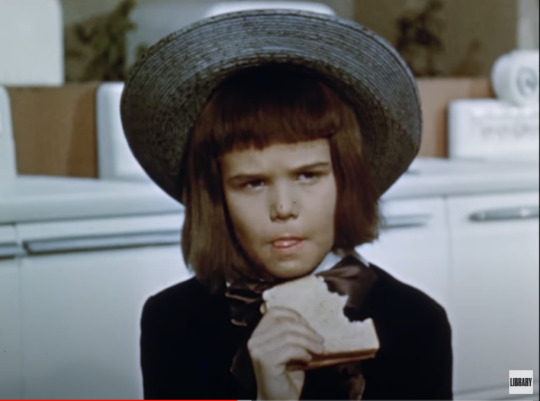
Anthony Sydes (Bobby, the Boy in Buster Brown Outfit) was 8 years old at the time of filming. He left the business in 1958 and died in 2015 at age 74.
With...
Lisa Abbott, Mildred Coles, Richard Crane, Nancy Hadley, Noreen Michaels, Crystal Reeves, Darla Ridgeway, Anne Rubin, Carol Lowe, Frances Zucco
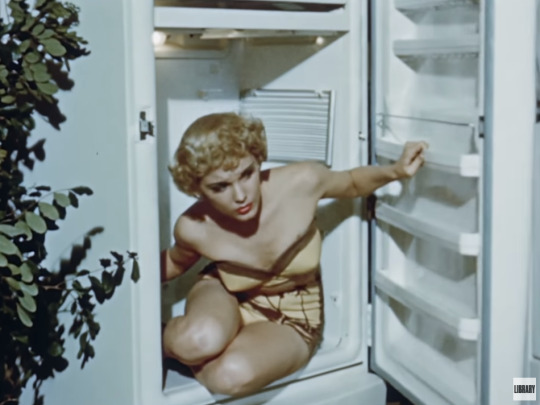
Uncredited Cast
Ralph Brooks (Stove Demonstrator) appeared in four films with Lucille Ball, as well as “The Lucy-Desi Milton Berle Special” and “Lucy Goes to Las Vegas” (TLS S3;E17).
Sam Harris (Showroom Guest) did a dozen films with Lucille Ball before appearing in the audience of Over the Teacups in “Ethel’s Birthday” (ILL S4;E8) and playing a subway passenger in “Lucy and the Loving Cup” (ILL S6;E12). In between, he was a wedding guest in Lucy and Desi’s film Forever Darling (1956). Along with Monty O'Grady and Murray Pollack, he was in the airport when “The Ricardos Go to Japan” in 1959.
Stuart Holmes (Showroom Guest) appeared with Lucille Ball in Lover Come Back (1946) and Critic’s Choice (1963).
Hans Moebus (Washer / Dryer Demonstrator) appeared as an uncredited background performer in hundreds of movies and TV shows, including the Lucille Ball films DuBarry Was a Lady (1943), A Woman of Distinction (1950) and The Facts of Life (1960). He was seen on the dock during the “I Love Lucy” episode “Bon Voyage” (ILL S5;E13) and part of the riverboat chorus in “Lucy Meets Arthur Godfrey” (TLS S3;E23).
Charles Sherlock (Television Viewer) appeared in three feature films with Lucille Ball from 1935 to 1963.
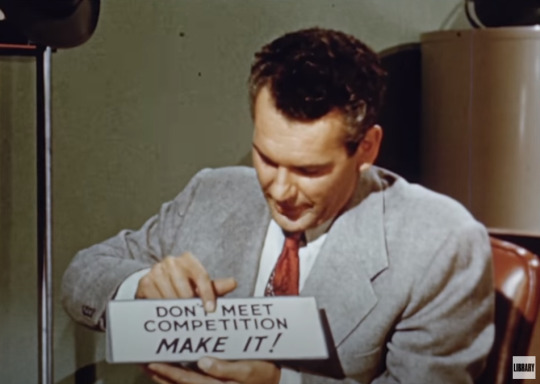
PART ONE - DON’T MEET COMPETITION, MAKE IT!
Westinghouse Rep Phil Pryer meets salesman Ellis Homan at his office on the department store showroom. Ellis tells Phil about the time he dozed off at his desk and the mannequins came to life: menswear, formal wear, beach wear, and (inexplicably) an American Indian in full regalia. Frosty the Refrigerator (James Mason) gets Ellis’ attention to demonstrate his frost-free features, as well as his unique butter tray and meat keeper.
Ellis then has a conversation with Speedy the Electric Range (Edward Arnold) about all its features. Ellis even makes coffee and cookies for Mabel, a mannequin standing in for a ‘prospect’.
MABEL: “Ellis, you’re cute. I wish you were a dummy.”
Ellis then has a chat with Pearly the Dishwasher (Maureen O’Sullivan) and Chop-Along Waste-Away the Garbage Disposal (Jerry Colonna), who sings during his demonstration.
Lanky the Water Heater (Andy Devine) is upset because no one pays him much attention. Pearly draws Ellis’s attention to the drip who has shown up in the showroom lately, the Dehumidifier (Percy Kilbride) who promises to rid homes of damaging dampness.
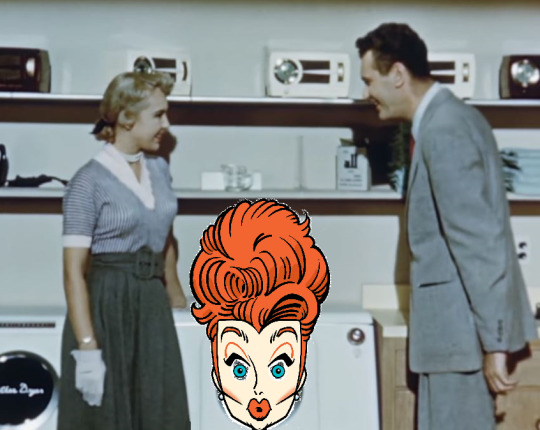
Chiming in (literally) Lina the Laundromat (Lucille Ball) and Dinah the Dryer (Marie Wilson) sing their greeting. Known as ‘The Westinghouse Twins’, they often finish each others’ sentences and speak at the same time - all in aid of showing that they are a perfect freedom-fighting duo in a home. Ellis demonstrates a typical wash cycle.
PART TWO - FREEDOM FAIR
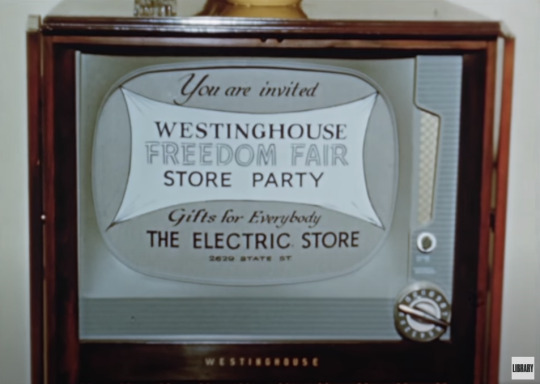
Back in the present, Phil tells Ellis that Westinghouse is sponsoring radio and television coverage of the summer’s 1952 Republican and Democratic conventions, with ‘Get Out the Vote’ programs to follow. In the meantime, Phil tells Ellis about the big Spring Selling Event - Freedom Fair. The event will be rolled out in the April 11, 1952 issue of Life Magazine and the April 16, 1952 issue of the Saturday Evening Post. On television, it will be announced by Betty Furness on “Studio One”.
After Phil leaves, the scene changes to a typical suburban couple’s bedroom where the morning alarm has just gone off. The bedraggled housewife dances through the home trying to get ready for the day ahead - despite the fact that she does not have any time-saving Westinghouse electric appliances. As the harried husband downs a quick cup of coffee and dashes off to work, the song begins (with offscreen vocals by the Starlighters) and the frustrated housewife realizes just how much work she has ahead of her to clean her home. Just then an ethereal voice sings the name “Westinghouse! Westinghouse!” and there is suddenly a handsome young salesman ringing her doorbell. He sings:
“They say that Lincoln freed the slaves, With that I disagree. Women have been slaves for years Till Westinghouse set them free!”
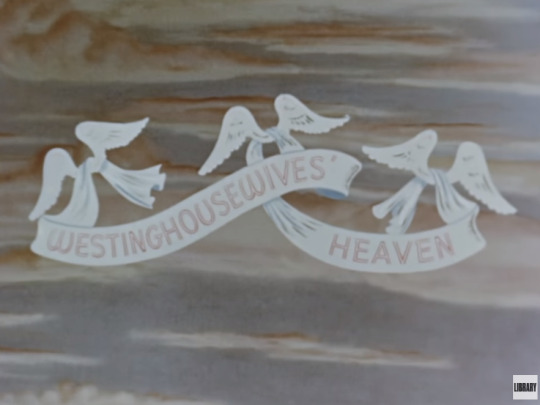
He whisks her away to ‘Westinghousewives’ Heaven’ where all the products we previously saw demonstrated are extolled in joyous song, some even have angel wings! The housewife (still in her curlers and pajamas) ducks behind a cloud and is suddenly revealed in a diaphanous white gown complete with apron! Amid a large group of ballet dancers, the Westinghousewife and Salesman dance in blissful happiness.
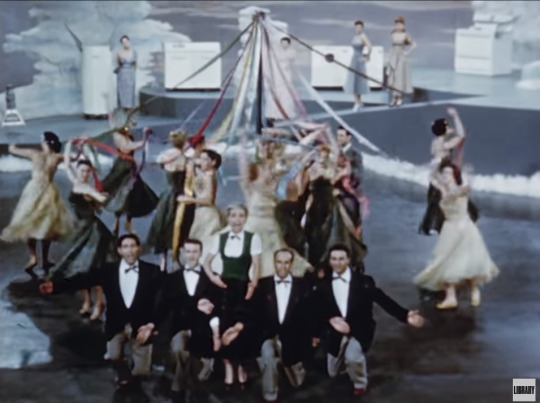
At the last moment the Starlighters appear and sing to us about Westinghouse, while the dancers swirl merrily around the May Pole!
Stereotypes
This film is obviously aimed at a male sales force. All the ‘prospects’ are assumed to be female and referred to in such terms as “the little lady”. The female mannequins are only interested in Ellis as romantic partners. Clearly, housewives were the main target of male salesmen.
The film also presents a stereotypical black chauffeur, the only person of color in the cast. The actor is asked to pull comical faces that make him appear silly - the source of humor
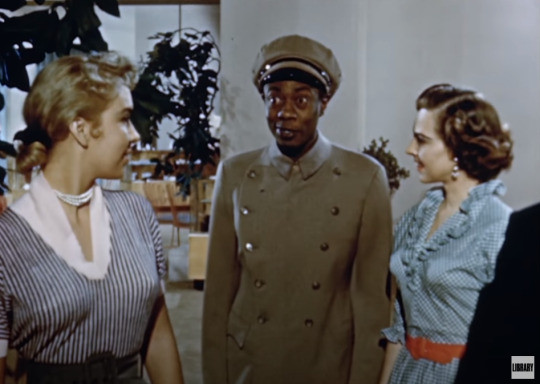
“Mmmm. There’s gonna be a watermelon missin’, ‘round here.”
Needless to say, that an American Indian chasing a scantily clad Caucasian woman around the store plays on stereotypical images of predatory Native Americans. The actor playing the Chief is Iron Eyes Cody, who, despite his name, was born Espera Oscar de Corti, an Italian-American. When trying to communicate all he says is “Ugg!”
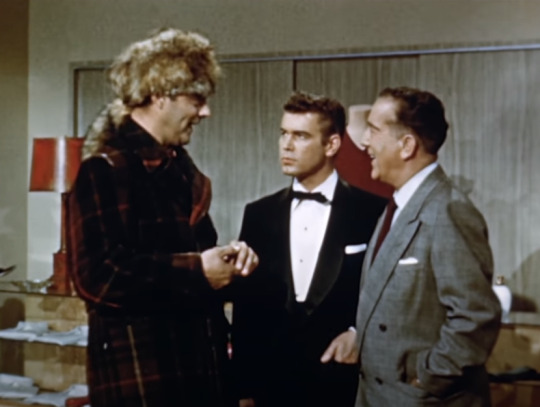
Homosexuals don’t escape either. A man with an effeminate manner and lisping voice wearing a coonskin cap swishes in to say “Hello, Fellas” with a toss of the raccoon tail he swans off. The two men in suits look uncomfortable and deny knowing him.
Voice casting reflects gender stereotypes of the time. Cooling and heating appliances are voiced by men while washing appliances are voiced by women.
Trivia
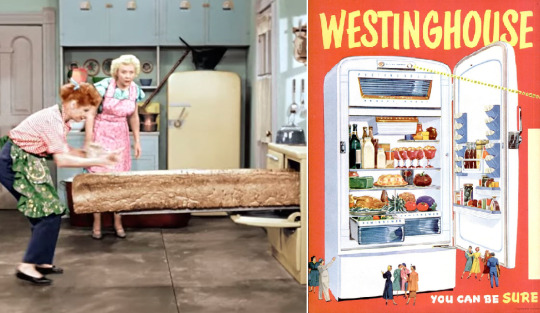
Lucille Ball’s participation in this film may have influenced or been influenced by the fact that for the first season of “I Love Lucy” Lucy Ricardo had a 1951 Westinghouse Frost-Free refrigerator in her kitchen - very similar to “Frosty” - the model shown here in the film. It was widely promoted in print publications and on TV during 1951. Previously, the freezer cabinet had to be thawed manually when frost and ice built up in and around it.
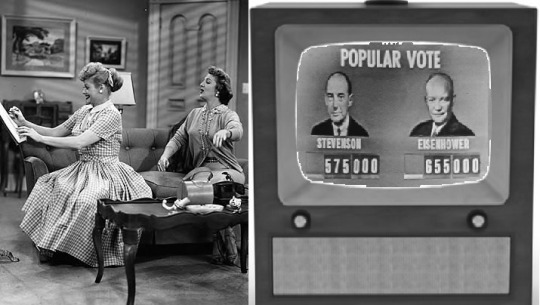
LUCY: “Didn’t you watch the conventions on television?”
Phil tells Ellis that Westinghouse will take out extensive advertising on radio and TV during the Conventions. In July 1952 both the Republican and Democratic National Conventions were televised live from Chicago. Although the conventions were also televised in 1948, few Americans owned a TV set to watch them. This time, an estimated 70 million voters watched the broadcasts, which ended with the nominations of Adlai Stevenson II and Dwight D. Eisenhower. There is a popular myth that Stevenson lost the election because of backlash from interrupting airings of “I Love Lucy” with hour-long campaign ads. Perhaps from Westinghouse? The conventions were mentioned on “I Love Lucy” (appropriately) in “The Club Election” (ILL S2;E19) which aired in February 1953. However, it was filmed in September 1952, when the reference would have been much more timely. By the time it eventually aired, Eisenhower had been inaugurated and the conventions were a distant memory.
Distribution: Who Saw It - The film series reached 25,000 dealers in 75 cities in a single week. Released in Technicolor and in 16mm. Longest of four dealer promotion films in a two-hour series produced to promote Westinghouse home appliances.
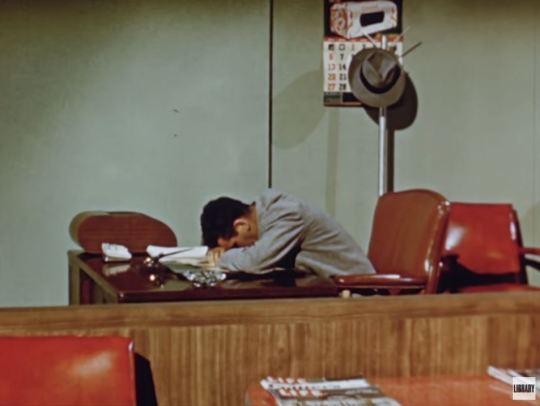
The wall calendar above Ellis’s desk matches the calendar for January 1952, which was likely the filming date. The calendar depicts a loaf of bread with the brand name redacted for filming. On the table close to the bottom of the frame are copies of Life Magazine. Later on, Ellis makes instant coffee from a jar labeled Maxwell House Coffee, although the dish washing detergent and the food in the fridge are obviously props with no brand identification. The laundry soap, however, is clearly labelled ‘All’ but is not in their usual bright colored packaging.
Blooper Alerts!
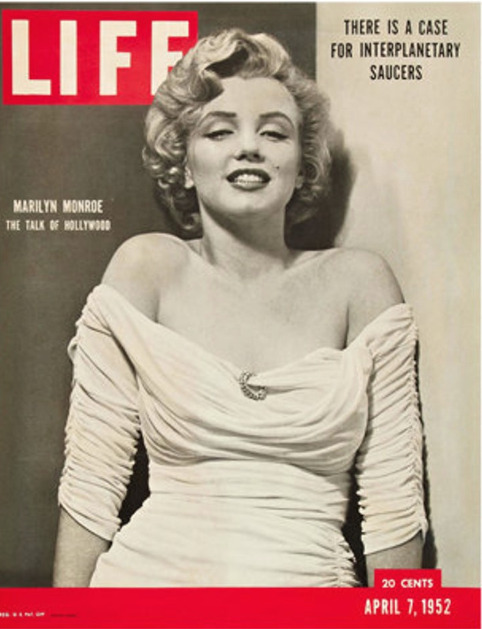

Dates! Phil tells Ellis that Freedom Fair will be announced in the April 11 issue of Life. However, the issue is actually dated April 7, 1952, not April 11. Interestingly, copies of Life Magazine are used as set decoration in Ellis’s office. Similarly, the April 16 edition of the Saturday Evening Post is really dated April 12.
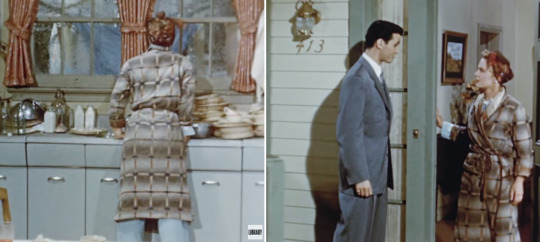
Weather Forecast! The put-upon housewife at the end of the film realizes her wash is still on the line when there is a sudden cloudburst (she does not own an electric dryer). The next moment, she answers the door to the Westinghouse Salesman and it is a clear day. Not really a blooper, just an indication that Westinghouse makes a rainy day into a sunny one - at least in the movies!
Fast Forward!

“Westinghouse Desilu Playhouse” was a television anthology series produced by Desilu Productions. The show ran on CBS between 1958 and 1960. Two of its 48 episodes served as pilots for the 1950s television series “The Twilight Zone” and “The Untouchables.” It also presented 11 of the 13 episodes of “The Lucy-Desi Comedy Hour” after its initial sponsorship by Ford.
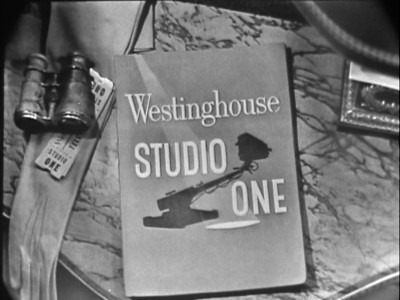
In joining forces with Desilu, Westinghouse canceled their other anthology series “Studio One” which ran on CBS from 1948 to 1958.
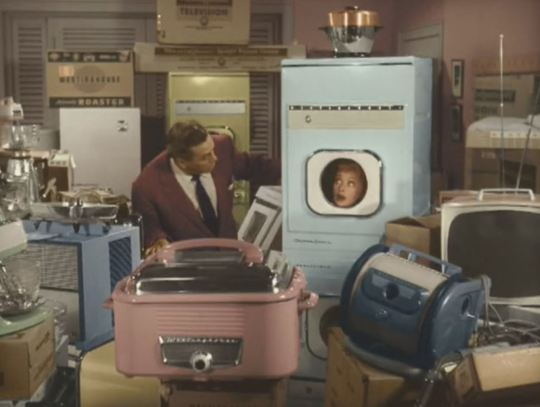
To kick off the partnership between Desilu and Westinghouse, a similar film (informally titled “Lucy Buys Westinghouse”) was produced which depicted Lucy and Desi giving a Westinghouse Executive a tour of their studio, formerly RKO. All through the tour, much to the dismay of Desi, Lucy is trying to order appliances for her dressing room from the executive! At the end, Lucy appears inside a Westinghouse dryer - hiding from Desi! Like Ellis in Freedomland, this film was only shown to Westinghouse employees. Unlike Ellis, it was filmed in black and white - only later colorized for home video. Throughout the film, Desi mispronounces the company’s name as “Westin-Gouse” and its spokesperson as Betty “Furnace”.
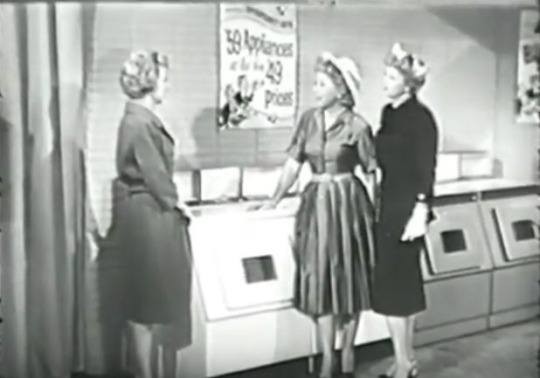
During that time, the cast often did long-form commercials for Westinghouse. Here, Betty Furness and Vivian Vance join Lucille Ball to talk about the 1959 Westinghouse washing machine, the same type of appliance Ball voiced in this film seven years earlier.
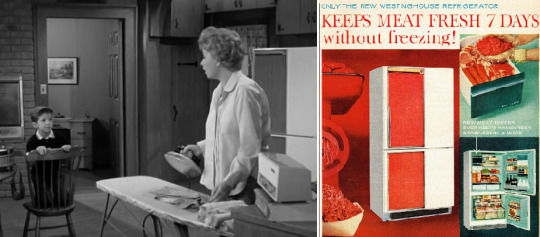
Naturally, during this period Lucy Ricardo had the most up-to-date Westinghouse appliances in her Westport home. Like this two-toned refrigerator and freezer.
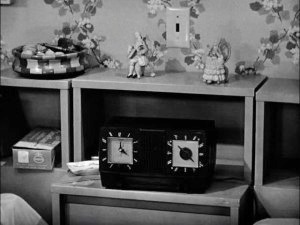
Back in New York City, the Ricardos owned a Westinghouse Clock Radio!
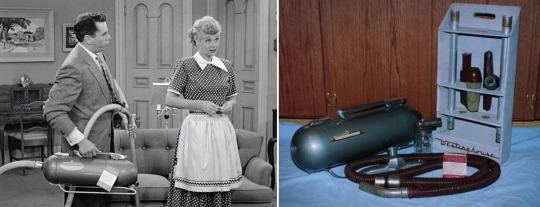
The Handy Dandy vacuum cleaner was actually a Westinghouse model!
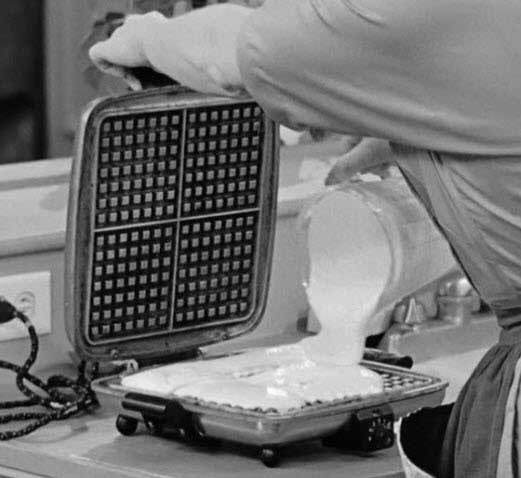
In 1954, Lucy made breakfast with her Westinghouse "Grill-n-Waffler" Waffle Iron - if only she can remember to pay the electricity bill, that is!
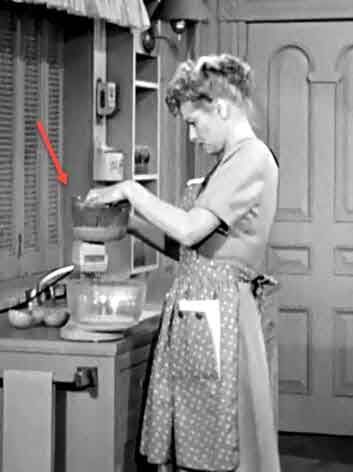
Lucy squeezes oranges for juice with her Westinghouse Model #FM-511 Food Crafter with juicer attachment (sold separately).
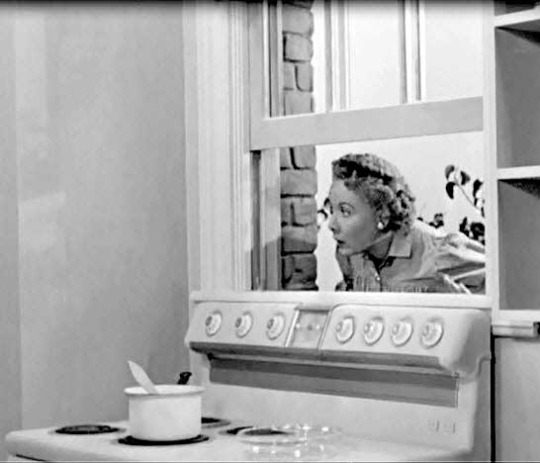
Lucy owned two different models of the Westinghouse Commander Super-Corox Range. This 1950 model was used during season one...
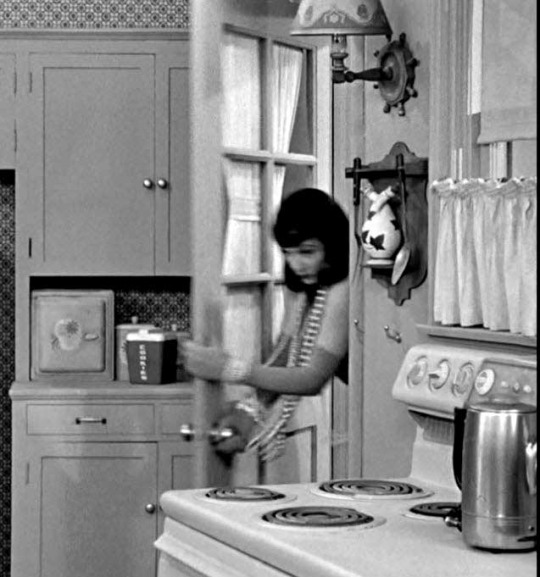
...and this 1954 Model on a later season. It looks similar to the 1950 model, but the controls have a different layout.
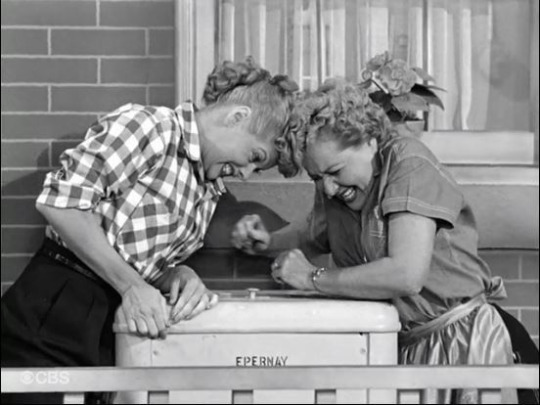
In 1953, ownership of a washing machine was a point of contention between the Ricardos and Mertzes. The appliance used in the episode is labeled Epernay (a fictional brand). In actuality, it is probably a Launderall Horton 500 with gas stove handles affixed to the sides to help move it back and forth on the narrow porch.
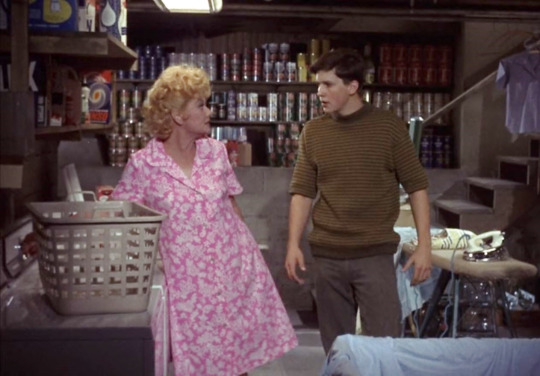
Lucy uses the washing machine (a lot!) in Yours, Mine and Ours (1968). It is impossible to see what brand it is.
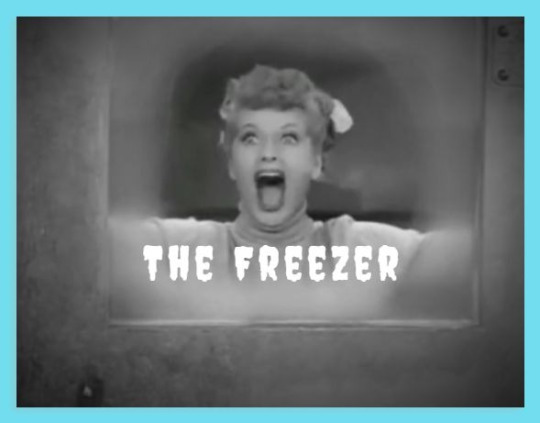
Coincidentally, in April 1952, “I Love Lucy” did an episode titled “The Freezer” (ILL S1;E29) where Lucy and Ethel want to buy a home freezer to economize, but end up buying a walk-in model instead. In Jess Oppenheimer’s book, he states that newspapers and magazines were full of ads for home freezers at the time. Once they came up with the idea of Lucy getting trapped in the freezer, they had to abandon the home freezer idea for a larger, walk-in model.
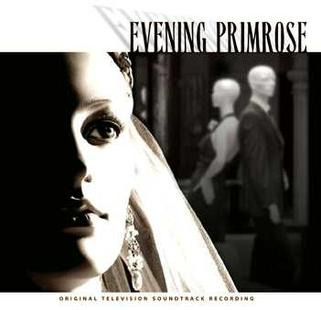
In 1966, a TV musical titled “Evening Primrose” with music by Stephen Sondheim and a book by George Furth, also explored the idea of department store mannequins coming to life. Anthony Perkins starred.
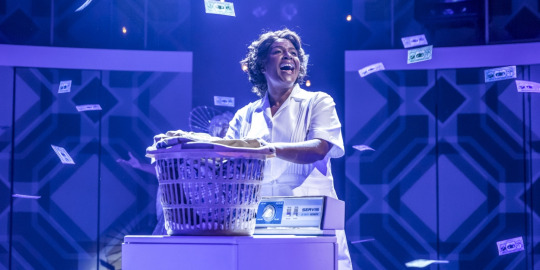
The idea of anthropomorphized laundry room appliances was also explored in the 2004 Broadway musical Caroline, or Change, in which actors played embodiment of the Washing Machine and the Dryer. A revival of the musical was on track for Broadway but interrupted by the Corona Virus pandemic.
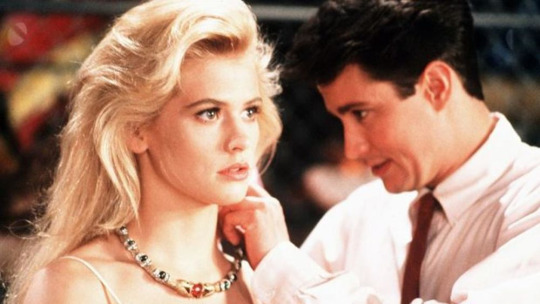
In 1987, the film Mannequin starring Andrew McCarthy and Kim Cattrall also explored the idea of department store mannequin coming to life. It was partly based on the 1948 film One Touch of Venus, although in that film, the mannequin was a statue.
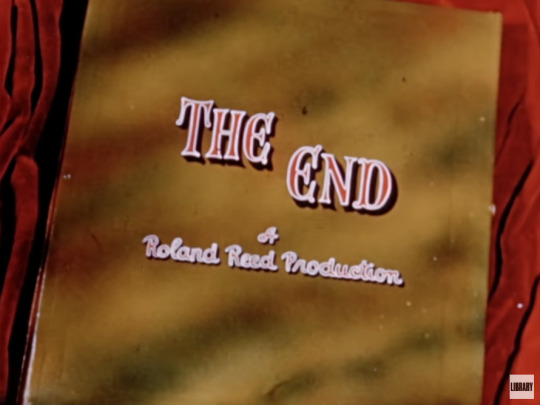
#Westinghouse#Lucille Ball#1952#I Love Lucy#Maureen O'Sullivan#Percy Kilbride#Jerry Colonna#Alan Hale Jr.#Alan Hale#Ellis in Freedomland#Edward Arnold#James Mason#Andy Devine#Vivian Vance#Marie Wilson#Betty Furness#Robert Rockwell#Robert Carson#Byron Foulger#Iron Eyes Cody#Willie Best
9 notes
·
View notes
Photo

Books I Read in 2019
#33 - The Underground Railroad, by Colson Whitehead
Mount TBR (22/100)
PopSugar Reading Challenge -- A book that’s becoming a movie mini-series in 2019
Rating: 3/5 stars
When I was in elementary school, I was taught the sanitized version of slavery and the Civil War, as most white Americans of similar age and background were. Even when I was studying the feats of Harriet Tubman and reading biographies of other, later activists like Mary McLeod Bethune, I was still dreadfully ignorant of what slavery truly was and the impact, even after its abolition, that it left in its wake, that still affects the country today. Since then, I haven't read much about American slavery, either fiction or nonfiction. Which I recognize now as part of my white privilege, that it's something I don't have to think about if I don't want to. For that reason, I'm grateful to this book for its unflinching depiction of what the life of a slave was like. The horror, the bleakness, the monotony coupled with the constant threat of brutality. When I was a child, it was easy to fall for the tale we were told--"No, they weren't free like we are, but they had their homes on the plantations and they worked and they were cared for by their masters." That simply isn't true, and while I will never experience anything like it myself, at least I know better now, and I can't believe the lie anymore. Beyond that, though, not much about this story affected me. Cora was such a bland protagonist I wondered early on if she was a blank slate deliberately, so that readers could project themselves on to her and feel the injustices of her life more closely; but after a while, there was such an emotional distance from her, a fog of detachment, that not only could I not imagine myself in her place, I couldn't even muster much interest in what happened to her next. All of the secondary characters were woefully underdeveloped. Caesar seems like he's going to be Cora's other half, the second protagonist, then disappears. The couple that shelters Cora next is barely there before they fall victim to the town mob. Royal saves Cora later on, and maybe loves her, or would have, but then that's over too, so suddenly. In fact, Ridgeway the slave catcher is probably the best developed of the lot, and should he be? Does a person of that temperament and occupation deserve so much investment in a story such as this? Structurally, I found the sudden backstory inserts alternately interesting and boggling, depending on whom they focused on. Explaining Caesar's decision to run, Mabel's flight, Ridgeway's family and upbringing...yeah, sure, okay. But the random chapter about the doctor-graverobber who never appeared again? Why did he get so much page time, and what purpose did that serve for the story? Finally, I wish more had been done with the concept of the literal Underground Railroad. It felt like a gimmick, with all the hand-waving and "who knows?" built into the narrative around it.
#booklr#book review#the underground railroad#colson whitehead#book photography#my photos#my reading challenges#mount tbr 2019#popsugar reading challenge 2019
2 notes
·
View notes
Text
A Blog study guide to Help Readers Understand Allusion
Introduction
The Underground Railroad by Colson Whitehead chronicles the experiences of a young slave girl Cora in her attempts to escape from slavery in the South and head north. Published in 2016, the novel won the National Book Award and the Pulitzer Prize in Fiction. This study guide provides an overview of the novel to help students and the average reader understand the main themes and message of the book. It starts with a brief summary of the book’s plot before going on to discuss the novel’s major characters. The study guide then concludes with an interpretation of the major themes and message of the novel.
Plot Summary
The story of the novel revolves around Cora, a young slave girl in a Georgian cotton plantation. Her life as a slave is extremely difficult but she is not for the idea of running away from the plantation to free herself. However, when Caesar, a slave who has just arrived from Virginia persuades her, she decides to follow him in making a daring escape. In this process, she kills a young white boy who tries to capture her. They manage to find a station and start their journey north. However, they are being pursued by Ridgeway, a determined slave catcher who is out to redeem his image from a previous failure.
The first stop for Cora and Caesar is in the state of South Carolina in a city that at first glance, looks like a safe haven. Here, she stays with the rest of escapee slaves who have been bought by the government and provided with jobs, medical care, and housing. However, she continues with her escape north when she learns the government is sterilizing black women and using black men to test the spread of syphilis. As Caesar is killed in South Carolina, Cora continues her journey through the states of North Carolina, Tennessee, and Indiana. Despite the help she gets throughout her journey, Cora still faces immense challenges. She is recaptured twice, her hosts are tortured, and even her last residence is torched. She also experiences attempted rape among other ordeals. At the end of the novel, the reader is not sure whether or not Cora reached her eventual destination and of freedom.
Major Characters of the Novel
Cora: The protagonist of the novel. She is a girl of about 10 years at the start of the story. Cora comes out as stubborn and determined. She is also brave and resourceful, consistently overcoming the obstacles on her journey.
Ridgeway: A slave-catcher with a good repute. His previous failure to recapture Mabel (Cora’s mother) makes him extremely determined to recapture Cora. He is eventually killed by Cora.
Ajarry: Cora’s grandmother. Born in Africa and enslaved into America. She is complacent and never imagined that slaves can free themselves.
Caesar: The slave from Virginia who convinces Cora to escape from the farm in Georgia. He was killed by a mob while in jail.
Other significant characters in the novel are: Mabel Cora’s mother, Boseman Ridgeway’s loyal follower, Randal the sadistic son of plantation owner, Connelly a cruel overseer at the plantation, and Royal the freeborn black slave who befriends and helps Cora.
Thematic Interpretation of the Novel: Slavery
The entire novel The Underground Railroad is about the institution of slavery. In other words, slavery is the major theme of the novel. However, slavery has different facets. The novel is dedicated towards addressing the different aspects of slavery which include racism, violence, and rebellion.
Racism
Racism is one of the sub-themes of the novel under slavery. Throughout the book, the reader comes across the idea being propagated by whites that the blacks are an inferior race. A good example of this is the sentiments of a North Carolina Whiteman Edgar Delany who knew that blacks “…..were descendants of cursed, black Ham, who had survived the flood by clinging to the peaks of a mountain in Africa” (Whitehead 157). This sentiment by Edgar represents the white narrative which portrayed blacks as a cursed inferior and barbaric race that was not capable of being free. This is the idea that informed enslavement and inhumane treatment of Africans as illustrated throughout the novel from Ajarry’s capture to Cora’s last fight with Ridgeways.
Violence
The novel also dwells a lot on the subject of violence illustrating how it was inseparable with slavery. Throughout the novel, the reader encounters too much violence meted on the black slaves ranging from caning, to mob justice, to rape and murder. For instance, at the initial stages of the novel it is described how Big Anthony was thoroughly whipped. He was “…whipped for the duration of their meal, and they ate slow” (45). On the other hand, Caesar was lynched by a mob, the same fate that befell Cora’s hosts in North Carolina. Even Cora herself was almost raped by Ridgeway’s man. It is illustrated that violence is a necessary tool for domination of slaves by the white.
Rebellion and Freedom
The novel also touches a lot on the theme of rebellion. All the black characters of the novel from Cora’s grandmother, Cora’s mother, and Cora herself are constantly pre-occupied with the choice between persevering the cruelty of slavery and rebelling. While some slaves thought that rebelling and escaping slavery was possible others thought that it was impossible. For instance, Ajarry Cora’s grandmother stated that “To escape the boundary of the plantation was to escape the fundamental principles of your existence: impossible” (Whitehead 13). This demonstrates her complacent belief that escaping slavery was impossible. This view contrasts with that of other slaves like Cora, Caesar, Mabel and many others who believed in rebelling their way to freedom through running away.
The Overlaying Message of the Novel
In depicting all these sub-themes, Whitehead portrays one message to his audience, that racism and slavery are not only cruel but also stubborn and persistent. This message is portrayed through the alteration of historical facts. For instance, in the novel Whitehead depicts how escapee slaves used underground railroads to make their way north. However, it is a fact that no underground railroads existed in the 19th century America connecting the South and the North. Rather, the underground railroads are used symbolically by Whitehead to refer to the network of white abolitionists who helped escapee slaves travel north (McGuire 1). However, despite the abolitionists’ efforts, it was still difficult for slaves to successfully make their way North. Despite the efforts slavery remained stubborn and persistent. This alteration of historical facts of the railroad demonstrates the persistence and stubbornness of slavery.
The sterilization of black women and use of black men to track spread of slavery are the other altered historical facts used by Whitehead meant to demonstrate persistence of slavery. In the novel, he depicts them to have happened in 19th century South Carolina but in real sense, they happened in the early 20th century. This alteration is also meant to illustrate that the racism that informed and propagated slavery in the 19th century persisted and is the one that also informed the syphilis and sterilization programs of the early 20th century. It was meant to illustrate that racism did not end with slavery but persisted in more covert forms. Thus, Whitehead uses alteration of historical facts to allude to the persistent and stubborn nature of slavery. Ultimately, he demonstrates that racism and slavery were not only cruel but also stubborn and persistent.
Works Cited
McGuire, Ian. "Colson Whitehead's 'the Underground Railroad' -- 'a Fantasia on Race
Relations'." FT.Com, 2016. ProQuest, https://search.proquest.com
/docview/1841674800?accountid=45049.
Whitehead Colson. "The Underground Railroad." (2016).
1 note
·
View note
Text
Colson Whitehead - La ferrovia sotterranea - Sur

8 Gennaio 2022 - La schiava nera Cora, nella Georgia della prima metà del XIX secolo, decide, dopo aver visto e subito angherie e violenze di ogni tipo, di fuggire dalla piantagione di cotone nella quale è costretta a lavorare. Lo fa assieme a Caesar, compagno di sventure e ideatore del piano di fuga. Il loro mezzo di spostamento è una misteriosa ferrovia sotterranea, della quale nessuno conosce i finanziatori e i costruttori; attraverso di essa inizia il loro viaggio verso l’agognato Nord degli USA, antischiavista e decisamente orientato verso l’avanzamento culturale ed economico delle persone di origine africana. Sulle loro tracce si mette il cacciatore di taglie Ridgeway, determinato a dare ai due filo da torcere e a riportarli nella piantagione, dove li aspetterebbero terribili torture prima di essere uccisi. A questo si aggiunge il sentimento di amore-odio di Cora nei confronti della madre Mabel, la quale sembrerebbe essere riuscita a fuggire dalla piantagione anni prima, lasciando la figlia al proprio destino.
Per questo romanzo distopico Colin Whitehead è stato insignito sia del National Book Award che del Premio Pulitzer. Riconoscimenti indubbiamente meritati, data l’importanza (e in alcuni casi l’attualità) del tema trattato. Questo è un romanzo che suscita sentimenti di rabbia quasi ad ogni pagina: rabbia per quel che è accaduto negli USA (e in altri posti nel mondo) riguardo la riduzione in schiavitù di intere generazioni di popoli strappati dalle loro terre e deportati nei paesi industrializzati per il lavoro nei campi e per l’impiego in altre mansioni umili e degradanti; per la schiavitù sessuale subita da molte ragazze e, spesso, anche da molte bambine da parte dei loro padroni; per le torture subite da parte di chi tentava di reagire alla schiavitù, o di fuggire da essa; per le delazioni che spesso gli stessi schiavi (ma anche gli ex schiavi affrancati) facevano nei confronti di altri schiavi, per paura o per semplice convenienza. Soprattutto, rabbia perché tutto questo, invariabilmente, è stato. L’unica distopia del romanzo è, appunto, nel suo titolo: quella ferrovia sotterranea che Cora e Caesar decidono di prendere per fuggire a Nord, per costruire la propria vita (lo dice la stessa Cora) fatta di piccole cose, di tranquillità, di concordia con tutte le persone del mondo.
È una speranza che ancora oggi molti, troppi, in quasi tutto il mondo, stanno rincorrendo.
#8 Gennaio 2022#Colin Whitehead#La ferrovia sotterranea#Sur#Razzismo#Schiavismo#USA#National Book Award#Premio Pulitzer#Ex Libris Philippi 2022
1 note
·
View note
Text
Thuso Mbedu gives a career-defining performance in The Underground Railroad

Thuso Mbedu in The Underground Railroad.
Picture: Kyle Kaplan/Amazon Studios
OUR RATING:
4/5 Stars
WHAT IT’S ABOUT:
The Underground Railroad tells an ‘various actuality’ the place folks making an attempt to free slavery in the US south used an precise railroad. It follows the story of Cora, a runaway slave as she makes use of the railroad to get to freedom.
WHAT WE THOUGHT:
Like Cora, The Underground Railroad takes us on a journey. We go between completely different states, completely different time intervals, various kinds of racism, and meet completely different characters alongside the best way. And what that leaves us with is not only a tackle slavery however on how the remnants of slavery and racism have been embedded in society and the hearts of many individuals. It’s a story of wrestle, ache, and most of all, of survival.
Based mostly on the Colson Whitehead guide of the identical identify, The Underground Railroad reimagines the real-life whisper community of secure homes and hiding locations that smuggled slaves out of the US South to the free states or Canada. On this model, it’s a literal underground railroad with trains and conductors that takes slaves from one state to a different. Cora (Thuso Mbedu) is haunted by the truth that her mom ran away and has had abandonment points since then. When one other slave Caesar (Aaron Pierre), means that she runs away with him, she is first reluctant after which decides to go together with him. We expertise the railroad and the escape routes by Cora’s eyes and the eyes of Ridgeway (Joel Edgerton), a slave-catcher who has a vendetta in opposition to Cora as Cora’s mom, Mabel (Sheila Atim), was the one slave he by no means caught after she ran away.
It’s troublesome to not rave about Mbedu’s efficiency. Cora is such an advanced character, born into ache, raised in ache, and hunted and adopted wherever she goes. Within the uncommon moments when she is allowed a bit of peace – when she is dancing with Caesar in South Carolina, or when she is with Royal (William Jackson Harper) in Indiana – her face virtually transforms, and he or she appears like a totally completely different particular person.
Click on ‘Learn Extra’ for the complete overview.
Source link
source https://fikiss.net/thuso-mbedu-gives-a-career-defining-performance-in-the-underground-railroad/ Thuso Mbedu gives a career-defining performance in The Underground Railroad published first on https://fikiss.net/ from Karin Gudino https://karingudino.blogspot.com/2021/05/thuso-mbedu-gives-career-defining.html
0 notes
Text
CBR9 Review #9: The Underground Railroad by Colson Whitehead
Colson Whitehead's Pulitzer Prize winning novel, The Underground Railroad, was another Mocha Girls Read book club selection. The novel follows Cora on her Odyssey-like journey to escape slavery traveling a magical realistic underground railroad.

“Here was the true Great Spirit, the divine thread connecting all human endeavor - if you can keep it, it is yours. Your property, slave or continent. The American imperative.” - page 80
It begins in Africa following the first slaves as they were stolen and brought over to America. From the jump, Whitehead does not mince words to describe the brutal reality of the sea voyage, rife with illness, suicide and violence. The brief introductory chapters were purposefully graphic to prime the reader for a dark look into American history. The author draws a fictional line between these first slaves to Mabel and her daughter Cora working on a cotton plantation in Georgia. When Cora is very little, her mother escapes in the night with no word. A legend grows around her to be the only slave from the plantation escape the slave catchers and dogs. Instead of inspiring Cora, it hardens her as she must make her way on her own from a young age. She is grouped with the mad women who never reproduced usually for mental or physical issues. There is a shaky camaraderie, but nothing is certain for the life of a slave.
She is resigned to her life until the evil brother, Terence, takes over the entire Randall plantation. He is basically a sociopath that enjoys torturing any slave that steps out of line. When Cora protects a small boy, he revels in making an example out of her with the whip. Another slave named Big Anthony is tortured and killed for show. That's the turning point when she agrees to leave with Caesar who knows where to find the railroad. Unfortunately, during their escape they injure a teenager part of the slave catching posse. Now wanted for murder, they run for their lives to South Carolina.
Plot spoilers lie ahead!
The rest of the book follows her as she appears to have every imaginable significant Black history event happen to Cora.
In South Carolina, she works as a nanny as part of their Negro education program. One day she is transferred to be on display at a museum. When she discovers the community doctor, Stevens, is secretly sterilizing women, she runs away on the railroad to North Carolina. We find out in a separate chapter, he used to be a grave robber to study bodies and make cash.
“Stolen bodies working stolen land. It was an engine that did not stop, its hungry boiler fed with blood. With surgeries that Dr. Stevens described, Cora thought, the whites had begun stealing futures in earnest. Cut you open and rip them out, dripping. Because that’s what you do when you take away someone’s babies - steal their future. Torture them as much as you can when they are on this earth, then take away the hope that one day their people will have it better.” - page 117
The mythical railroad whisks Cora to the attic of Martin & Ethel who inherited the stop from Martin's father. Not very faithful to the abolitionist cause more out of fear, they hide Cora. From the attic she witnesses the weekly Friday night lynchings.
“In North Carolina, the negro race did not exist except at the ends of ropes.” - page 156
Bad luck befalls her again when the couple's Irish maid snitches for the paltry reward despite her societal position not much above Cora’s. Before the town could hang Cora, Ridgeway a determined slave catcher claims her with glee.
“ “We do our part, “ Ridgeway said, “slave and slave catcher. Master and colored boss. The new arrivals streaming into the harbors and the politicians and sheriffs and newspapermen and the mothers raising strong sons. People like you and your mother are the best of your race. The weak of the tribe have been weeded out, they die in the slave ships, die of our European pox, in the fields working our cotton and indigo. You need to be strong to survive the labor and to make us greater. We fatten our hogs, not because it pleases us but because we need hogs to survive. But we can’t have you too clever. We can’t have you so fit you outrun us.” “ - page 222
They make their way through plague stricken Oklahoma/Tennessee with the help of Royal and other free slaves catching the slave catcher off-guard. The Nat Turner of the story. Together, they make their way to Indiana to the black owned Valentine farm. The two opposing views of abolition are channeled into the characters, Lander and Mingo debating the fate of the farm. Should they turn away slaves to keep easy truce with the whites or defy them and take in any black person seeking shelter? It turns violent before the answer comes by Ridgeway and his young black assistant, Homer. She was happy for a time with Royal before violence descends again. She does eventually make her way to the North. The book ending open at a crossroads, reader unsure on where freedom will take Cora.
“Lumbly’s words returned to her: If you want to see what this nation is all about, you have to ride the rails. Look outside as you speed through, and you’ll find the true face of America. It was a joke, then, from the start. There was only darkness outside the windows on her journeys, and only ever would be darkness.” - page 262-263
I loved Colson Whitehead's biting condemnation of America shown in my selected excerpts. My favorite parts were these musings intermixed with historical nuggets he uncovered in his research. However, I felt hammered down by the actual narrative. It took me way too long to finish this book. There's not much light at the end of the railroad, which I know is realistic. However, all these events happening to the same person seemed less so. I was ready to love it, but I guess the hype raised the bar too high. At times, the author's descriptions are needlessly long winded. Characters disappear with not much explanation or fanfare. The book has a meandering, non-linear chapter approach to the story. He does return to key characters to give them epilogues before the final chapter of Cora's story. If you're curious about this period of American history, I do think this is an excellent book to read. It's more of a class assignment than a literary pleasure read for me. I'm curious to read more from the author, but I can't say I loved this award winning book.
This is my ninth review for Cannonball Read 9. An annual, memorial book challenge to read and review 52 books in a year. Or 26. Or 13. Choose your level and read to meet your goal all while fundraising for the American Cancer Society in the memory of AlabamaPink.
#the underground railroad#colson whitehead#pulitzer prize#national book award#book review#black history#african american history#fiction#literary hype#slavery#american slavery#historical fiction#cannonball read#cbr9
0 notes
Photo





The party continued well into the night. Everyone had a wonderful time! Drinks were flowing, the dance floor was always full, and laughter echoed out of the barn. It was the perfect end to the perfect day!
#the sims#the sims 4#sims 4#ts4#simblr#sims#ridgeway#ridgeway gen 1#ridgeway family#ridgeway legacy#mabel ridgeway
21 notes
·
View notes
Photo



Mabel had struck a deal with Kim, the owner of the grocery stall, where she could trade some of her surplus fish for cooking ingredients. Money was still pretty tight for Mabel, so the ability to haggle was a lifesaver!
#the sims#the sims 4#sims 4#ts4#simblr#sims#ridgeway#ridgeway legacy#ridgeway gen 1#ridgeway family#mabel ridgeway
22 notes
·
View notes
Photo


Mabel could feel tears starting to well in her eyes, so quickly got up before Michael saw. She didn’t want to guilt trip him about his feelings, because they were completely valid. But the thought of having to wait another year before getting to start her family stung. What is going to be different in a year?
“Mabel, come back!”
Michael caught her at the bottom of the stairs and pulled her into a hug, which made everything seem a little better.
“I’m sorry, Michael. I’m just being silly. Ignore me.”
“You’re not! Look, I maybe should have said something before now. I just want to make sure that we’re in the right space for kids. They’re a big life change and they don’t ask to be born, so I want to make sure we can give them the best of the best.”
“I can understand that...but...”
“But what?”
“Well, we can give them everything now? We moved into this house that has more space to raise a child. We’re financially secure. We’re married. I just don’t see what other boxes we need to tick before we’re ready. There’s no ‘right’ time to have a child, but if there were we’d be there.”
“Emotionally I don’t think I can have a child. I don’t really want one, and I don’t want to end up resenting one.Is this a deal breaker for you?”
“Well...no...I guess a year isn’t really that long to wait. We’ll put a pin in this until then.”
#the sims#the sims 4#sims 4#ts4#simblr#sims#ridgeway#ridgeway gen 1#ridgeway family#ridgeway legacy#mabel ridgeway
14 notes
·
View notes
Photo




The best part about camping is cooking things over the fire!
#the sims#the sims 4#sims 4#ts4#simblr#sims#ridgeway#ridgeway gen 1#ridgeway family#ridgeway legacy#mabel ridgeway
19 notes
·
View notes
Photo



Sara was delighted with the produce that Mabel had found! She immediately invited Mabel round to the Gnome’s Arms to try a sampler of the drink!
#the sims#the sims 4#sims 4#ts4#simblr#sims#ridgeway#ridgeway family#ridgeway legacy#ridgeway gen 1#mabel ridgeway
18 notes
·
View notes
Photo



Mabel fell in love straight away! He’s such a gentle soul
#the sims#the sims 4#sims 4#ts4#simblr#sims#ridgeway#ridgeway gen 1#ridgeway legacy#ridgeway family#mabel ridgeway
17 notes
·
View notes
Photo




The little berry that looked like a cow actually turned out to be a cow! Well kind of, it was a cowplant! Mabel named her Mootilda.
She’d never seen a plant like this before, but after talking with Michael it turns out they’re carnivorous plants. If they don’t have a steady supply of meat, they can eat unsuspecting sims! Mabel was a little nervous at first, but Mootilda was a playful little scamp and soon put her at ease.
Mabel did make a mental note to keep Mootilda well fed though...
#the sims#the sims 4#sims 4#ts4#simblr#sims#ridgeway#ridgeway gen 1#ridgeway family#ridgeway legacy#mabel ridgeway
16 notes
·
View notes